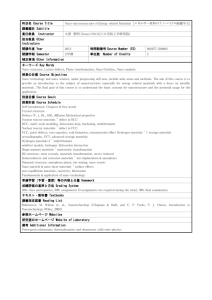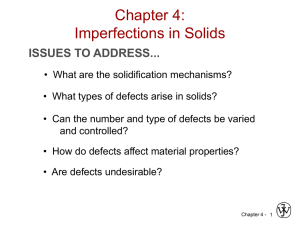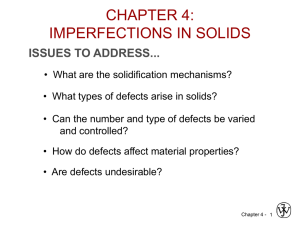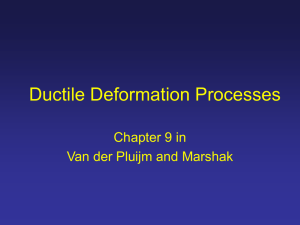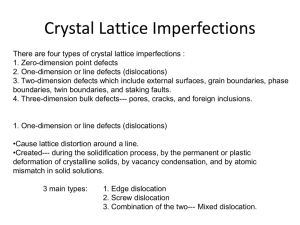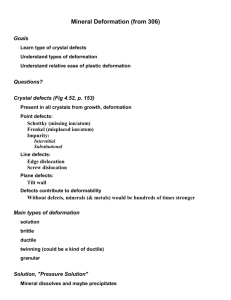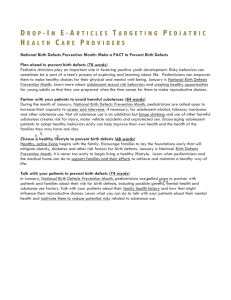CHAPTER 4: IMPERFECTIONS IN SOLIDS
advertisement
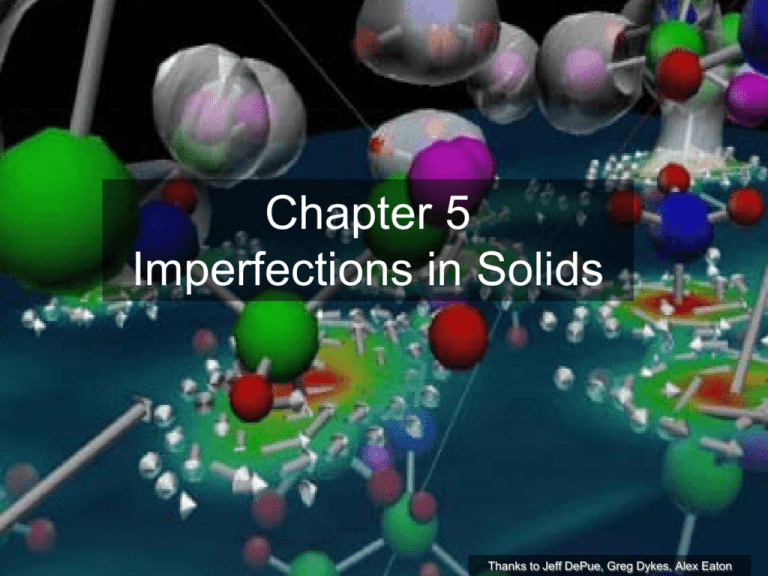
Chapter 5
Imperfections in Solids
Thanks to Jeff DePue, Greg Dykes, Alex Eaton
CHAPTER 5:
IMPERFECTIONS IN SOLIDS
ISSUES TO ADDRESS...
• What are the solidification mechanisms?
• What types of defects arise in solids?
• Can the number and type of defects be varied
and controlled?
• How do defects affect material properties?
• Are defects undesirable?
Chapter 5 - 2
5.1 Introduction
• Every single solid has defects and
imperfections.
• Sometimes the imperfections are purposely
created and used for a specific purpose.
• Types of defects:
– Point Defects (One or two atomic positions)
– Linear Defects (One Dimensional)
– Interfacial Defects (Boundaries)
5.1 Imperfections in Solids
• Solidification- result of casting of molten material
– 2 steps
• Nuclei form
• Nuclei grow to form crystals – grain structure
• Start with a molten material – all liquid
nuclei
crystals growing
liquid
grain structure
Adapted from Fig. 5.19 (b), Callister & Rethwisch 3e.
• Crystals grow until they meet each other
Chapter 5 - 4
Polycrystalline Materials
Grain Boundaries
• regions between crystals
• transition from lattice of
one region to that of the
other
• slightly disordered
• low density in grain
boundaries
– high mobility
– high diffusivity
– high chemical reactivity
Adapted from Fig. 5.12,
Callister & Rethwisch 3e.
Chapter 5 - 5
Solidification
Grains can be - equiaxed (roughly same size in all directions)
- columnar (elongated grains)
~ 8 cm
heat
flow
Columnar in
area with less
undercooling
Adapted from Fig. 5.17,
Callister & Rethwisch 3e.
Shell of
equiaxed grains
due to rapid
cooling (greater
∆T) near wall
Grain Refiner - added to make smaller, more uniform, equiaxed grains.
Chapter 5 - 6
Imperfections in Solids
There is no such thing as a perfect crystal.
• What are these imperfections?
• Why are they important?
Many of the important properties of
materials are due to the presence of
imperfections.
Chapter 5 - 7
Types of Imperfections
• Vacancy atoms
• Interstitial atoms
• Substitutional atoms
Point defects
• Dislocations
Line defects
• Grain Boundaries
Area defects
Chapter 5 - 8
I. Point
defects
Chapter 5 - 9
5.2 Point Defects in Metals
• Vacancies:
-vacant atomic sites in a structure.
Vacancy
distortion
of planes
• Self-Interstitials:
-"extra" atoms positioned between atomic sites.
selfinterstitial
distortion
of planes
Chapter 5 - 10
Equilibrium Concentration:
Point Defects
• Equilibrium concentration varies with temperature!
No. of defects
No. of potential
defect sites
Activation energy
Q
Nv
= exp − v
kT
N
÷
÷
Temperature
Boltzmann's constant
-23
(1.38 x 10 J/atom-K)
-5
(8.62 x 10 eV/atom-K)
Each lattice site
is a potential
vacancy site
Chapter 5 - 11
Measuring Activation Energy
• We can get Qv from
an experiment.
−Q
Nv
v
exp
=
kT
N
• Measure this...
• Replot it...
Nv
ln
N
Nv
N
÷
÷
slope
-Qv /k
exponential
dependence!
T
1/T
defect concentration
Chapter 5 - 12
Estimating Vacancy Concentration
• Find the equil. # of vacancies in 1 m3 of Cu at 1000°C.
• Given:
ρ = 8.4 g /cm 3
A Cu = 63.5 g/mol
Qv = 0.9 eV/atom NA = 6.02 x 1023 atoms/mol
0.9 eV/atom
−Q
Nv =
v÷
÷
-4
exp
kT = 2.7 x 10
N
For 1
m3 ,
N= ρ x
NA
A Cu
1273 K
8.62 x 10-5 eV/atom-K
x 1 m3 = 8.0 x 1028 sites
• Answer:
Nv = (2.7 x 10-4)(8.0 x 1028) sites = 2.2 x 1025 vacancies
Chapter 5 - 13
5.2 Point Defects in Metals
•
Vacancies:
– Impossible to create a material
without vacancies due to the laws of
Thermodynamics.
– The number of vacancies (Nv) is
calculated with the following formula:
Nv = N exp(-Q/kT)
N = number of atomic sites;
Q = energy for vac. formation;
k = boltzmann’s constant
= 1.38×10-23 J/atom-K
= 8.62×10-5 eV/atom-K
T = absolute temperature (K)
http://www.matter.org.uk/matscicdrom/manual/po.html
5.2 Point Defects in Metals
• Self Interstitial:
– When an atom is
pushed into an
interstitial site which is
normally unoccupied.
– Very small amount in
metals because when it
occurs, it highly distorts
the metal.
– Much lower
concentrations than
vacancies.
http://www.substech.com/dokuwiki/doku.php?id=imp
erfections_of_crystal_structure
5.3 Point Defects in Ceramics (i)
• Vacancies
-- vacancies exist in ceramics for both cations and anions
• Interstitials
-- interstitials exist for cations
-- interstitials are not normally observed for anions because anions
are large relative to the interstitial sites
Cation
Interstitial
Cation
Vacancy
Anion
Vacancy
Adapted from Fig. 5.2, Callister &
Rethwisch 3e. (Fig. 5.2 is from
W.G. Moffatt, G.W. Pearsall, and
J. Wulff, The Structure and
Properties of Materials, Vol. 1,
Structure, John Wiley and Sons,
Inc., p. 78.)
Chapter 5 - 16
Point Defects in Ceramics (ii)
• Frenkel Defect
-- a cation vacancy-cation interstitial pair.
• Shottky Defect
-- a paired set of cation and anion vacancies.
Shottky
Defect:
Adapted from Fig. 5.3, Callister &
Rethwisch 3e. (Fig. 5.3 is from
W.G. Moffatt, G.W. Pearsall, and
J. Wulff, The Structure and
Properties of Materials, Vol. 1,
Structure, John Wiley and Sons,
Inc., p. 78.)
Frenkel
Defect
• Equilibrium concentration of defects
∝ e −QD /kT
Chapter 5 - 17
5.3 Point Defects in Ceramics
• More types of defects than metals because
there are more types of ions.
• In order to keep electroneutrality, ions must
be lost in equal amounts of charge. For
example: One cation and one anion.
• Two main types: Frenkel Defect, Shottky
Defect
• Most ceramics stay in a stoichiometric state,
that is, they generally keep the same ratios as
predicted by their empiracle formula.
– Exceptions occur in atoms like iron: Fe2+ and Fe3+
Frenkel Defect
• Neighboring cation
vacancy and cation
interstitial.
• Nfr = N exp(-Qfr/2kT)
Shottky Defect
• Neighboring cation
vacancy and anion
vacancy.
• Ns=N*exp(-Qs/2kT)
http://mrsec.wisc.edu/Edetc/SlideShow/slides/defects/
Schottky_Frenkel.html
5.4 Impurities in Metals
Two outcomes if impurity (B) added to host (A):
• Solid solution of B in A (i.e., random dist. of point defects)
OR
Substitutional solid soln.
(e.g., Cu in Ni)
Interstitial solid soln.
(e.g., C in Fe)
• Solid solution of B in A plus particles of a new
phase (usually for a larger amount of B)
Second phase particle
-- different composition
-- often different structure.
Chapter 5 - 21
Impurities in Metals
Conditions for substitutional solid solution (S.S.)
– 1. ∆r (atomic radius) < 15%
– 2. Proximity in periodic table
• i.e., similar electronegativities
– 3. Same crystal structure for pure metals
– 4. Valency
• All else being equal, a metal will have a greater tendency
to dissolve a metal of higher valency than one of lower
valency
Chapter 5 - 22
Imperfections in Metals (iii)
Element
1. Would you predict
more Al or Ag
to dissolve in Zn?
2. More Zn or Al
in Cu?
Cu
C
H
O
Ag
Al
Co
Cr
Fe
Ni
Pd
Zn
Atomic Crystal
Radius Structure
(nm)
0.1278
0.071
0.046
0.060
0.1445
0.1431
0.1253
0.1249
0.1241
0.1246
0.1376
0.1332
Electronegativity
Valence
FCC
1.9
+2
FCC
FCC
HCP
BCC
BCC
FCC
FCC
HCP
1.9
1.5
1.8
1.6
1.8
1.8
2.2
1.6
+1
+3
+2
+3
+2
+2
+2
+2
Table on p. 159, Callister & Rethwisch 3e.
Chapter 5 - 23
Imperfections in Ceramics
• Electroneutrality (charge balance) must be maintained
when impurities are present
Cl • Ex: NaCl Na +
• Substitutional cation impurity
cation
vacancy
Ca 2+
Na +
Na +
without impurity
Ca 2+ impurity
• Substitutional anion impurity
O2-
without impurity
Cl Cl O2- impurity
Ca 2+
with impurity
anion vacancy
with impurity
Chapter 5 - 24
5.4 Impurities in Solids
5.4 Impurities in Solids
• Solid Solutions:
– Substitutional replacement of ions
– Interstitial - filling of
voids
– Dependent on:
•
•
•
•
Atomic size factor
Crystal Structure
Electronegativity
Valences
Impurities in Ceramics
• Both types as well
• Can occur for the cations or
for the anions
• Usually both occur at same
time (one cation and one
anion).
Up to here on Thursday}
http://www.chem.ufl.edu/%7Eitl/2045/lectures/lec_i.html
5.5 Point Defects in Polymers
•
Defects due in part to chain packing errors and impurities such
as chain ends and side chains
Adapted from Fig. 5.7,
Callister & Rethwisch 3e.
Adapted from Fig. 5.7,
Callister & Rethwisch 3e.
{Start here on Tuesday}
Chapter 5 - 27
5.5 Point Defects in Polymers
•
•
•
•
Different from ceramics and metals
Chains can bond together forming loops.
Chains can tie two molecules together.
Impurities may include interstitials, side
branches, or incorrect bending.
• Vacancies can occur and alter the chain
sequence.
• Every chain end is considered a defect.
5.6 Specification of Composition (or
concentration)
• Specification of composition
– weight percent
m1
C1 =
x 100
m1 + m2
m1 = mass of component 1
– atom percent
n m1
x 100
C =
n m1 + n m 2
'
1
nm1 = number of moles of component 1
Chapter 5 29
5.6 Specification of Composition
• Two types of composition
specification:
– Weight percent of atoms “1” and “2”:
C1 = [m1/(m1+m2)]*100
– Atom percent
C’1 = [n1/(n1+n2)]*100
m = mass; n = moles
(Compositions are easily converted from
one type to the other by manipulating m
to n, or vice versa, using the atomic
weight, A)
II.
Miscellaneous
Imperfections
Chapter 5 - 31
5.7 Line Defects
Dislocations:
• are line defects,
• slip between crystal planes result when dislocations move,
• produce permanent (plastic) deformation.
Schematic of Zinc (HCP):
• before deformation
• after tensile elongation
slip steps
Chapter 5 - 32
Imperfections in Solids
Linear Defects (Dislocations)
– Are one-dimensional defects around which atoms are
misaligned
• Edge dislocation:
– extra half-plane of atoms inserted in a crystal structure
– b perpendicular (⊥) to dislocation line
• Screw dislocation:
– spiral planar ramp resulting from shear deformation
– b parallel (||) to dislocation line
Burger’s vector, b: measures the magnitude and direction of
the lattice distortion
Chapter 5 - 33
Imperfections in Solids
extra half-plane of atoms inserted
in a crystal structure
Edge Dislocation
Fig. 5.8, Callister & Rethwisch 3e.
Chapter 5 - 34
Imperfections in Solids
Screw Dislocation: b || dislocation line
Screw Dislocation
b
Dislocation
line
Burgers vector b
(b)
(a)
Adapted from Fig. 5.9, Callister & Rethwisch 3e.
Chapter 5 - 35
Edge, Screw, and Mixed Dislocations
Mixed
Edge
Adapted from Fig. 5.10, Callister & Rethwisch 3e.
Screw
Chapter 5 - 36
Imperfections in Solids
Dislocations are visible in electron micrographs; TEM
Titanium alloy, dark lines are dislocations 51,450x
Fig. 5.11, Callister & Rethwisch 3e.
Chapter 5 - 37
5.7 Dislocations – Linear
Defects
• A dislocation is a linear (one dimensional) defect
around which other atoms are misaligned
• Edge Dislocation – where an extra plane or half plane
of atoms stops
• Screw Dislocation – where a shear stress causes a
region of a crystal to shift
• Mixed Dislocation – a combination of edge and screw
dislocations
• Burges Vector – the magnitude and direction of
lattice distortion associated with a dislocation
5.7 Continued
Edge Dislocation
http://www.mtmi.vu.lt/legacy/pfk/funkc_dariniai/sol_st_phys/images/dislocation.gif
Screw Dislocation
http://www.siliconfareast.com/screwdislocation.jpg
5.8 Interfacial defects
2D Boundaries
Separate xtal structures & xtalographic orientations
Examples:
-external surfaces
-Lower nearest neighbors
-Atoms in higher energy states
-Tend to minimize the total surface area
- grain boundaries
-Low angle
example: tilt boundary
-High angle
- twin boundaries
- stacking faults
- phase boundaries (in multiphased materials)
Chapter 5 -
Chapter 5 - 41
• twin boundary (plane)
– Essentially a reflection of atom positions across the twin
plane.
Adapted from Fig. 5.14,
Callister & Rethwisch 3e.
• Stacking faults
– For FCC metals an error in ABCABC packing sequence
– Ex: ABCABABC
Chapter 5 - 42
Catalysts and Surface Defects
• A catalyst increases the
rate of a chemical
reaction without being
“consumed”
• Active sites on catalysts
are normally surface
defects
Fig. 5.15, Callister & Rethwisch 3e.
Single crystals of
(Ce0.5Zr0.5)O2
used in an automotive
catalytic converter
Fig. 5.16, Callister & Rethwisch 3e.
Chapter 5 - 43
5.8 Interfacial Defects
•
•
•
•
•
•
Interfacial defects are two dimensional boundaries with different
crystal structures and/or orientations
External Surfaces – where the crystal terminates
Grain Boundaries – crystals often form groups of atoms known
as grains, which when combined with other grains in a large
crystal, often have misalignments that form boundaries
Phase Boundaries – where a crystal forms more than one phase
(i.e. solid and liquid)
Twin Boundaries – A special grain boundary where one grain
forms a mirror lattice symmetry with another
Other miscellaneous interfacial defects include stacking faults
and ferromagnetic domain walls.
5.8 Interfacial Defects
Grain Boundary
http://www.corrosionlab.com/Failure-Analysis-Studies/Failure-Analysis-Images/20030.SCC.304Hpipeline/20030.microstructure-ditched-grain-boundaries.jpg
5.9 Bulk or Volume defects
(Introduced during processing and fabrication steps)
Pores
Cracks
“Foreign” inclusions
Other phases
Chapter 5 - 46
5.9 Bulk or Volume Defects
• Much larger defects than the previous
ones, usually introduced during
processing and fabrication
• Examples include:
– Pores
– Cracks
– Foreign Inclusions
– Other Phases
http://www.fossil.energy.gov/images/education/rockpore.jpg
5.10 Atomic Vibrations
(Introduce during the creation of the universe)
Every atom vibrates even at zero Kelvin
(OK)
Frequencies in the order of 10 THz
Chapter 5 - 48
III.Microscopic
Examination
Chapter 5 - 49
5.10 Microscopic Examination
• Crystallites (grains) and grain boundaries.
Vary considerably in size. Can be quite large.
– ex: Large single crystal of quartz or diamond or Si
– ex: Aluminum light post or garbage can - see the
individual grains
• Crystallites (grains) can be quite small (mm
or less) – necessary to observe with a
microscope.
Chapter 5 - 50
5.10 Atomic Vibrations
• At any given time, each atom in a crystal is
vibrating about its lattice position within the
crystal
• The amplitudes and frequencies of the
vibrations vary between atoms and can be
considered imperfections or defects
• The vibrations change with temperature and
influence many properties of the crystal such
as melting point
5.11 Microscopic Examination – General
• The grains of many crystals have diameters
in the order of microns (10-6 meters)
• Microstructure – Structural features subject to
observation under a microscope
• Microscopy – Use of a microscope in studying
crystal structure
• Photomicrograph – A picture taken by a
microscope
5.11 Microscopic Examination – General
http://rsic.puchd.ac.in/images/i
mage002.jpg
Electron Microscope
Optical Microscope
http://science.kukuchew.com/wpcontent/uploads/2008/06/modern
microscope.jpg
Scanning Probe Microscope
http://img.directindustry.com/i
mages_di/photo-g/scanningprobe-microscope-spm47975.jpg
5.12 Optical Microscopy
• Useful up to 2000X magnification.
• Polishing removes surface features (e.g., scratches)
• Etching changes reflectance, depending on crystal
orientation.
crystallographic planes
Adapted from Fig. 5.18(b) and (c), Callister
& Rethwisch 3e. (Fig. 5.18(c) is courtesy
of J.E. Burke, General Electric Co.)
Micrograph of
brass (a Cu-Zn alloy)
0.75mm
Chapter 5 - 54
5.12 Optical Microscopy
Grain boundaries...
• are imperfections,
• are more susceptible
to etching,
• may be revealed as
dark lines,
• change in crystal
orientation across
boundary.
polished surface
surface groove
grain boundary
(a)
ASTM grain
size number
N = 2n-1
number of grains/in2
at 100x
magnification
Fe-Cr alloy
Adapted from Fig. 5.19(a)
and (b), Callister &
Rethwisch 3e.
(Fig. 5.19(b) is courtesy
of L.C. Smith and C. Brady,
the National Bureau of
Standards, Washington, DC
[now the National Institute of
Standards and Technology,
Gaithersburg, MD].)
(b)
Chapter 5 - 55
Optical Microscopy
• Polarized light
– metallographic scopes often use polarized
light to increase contrast
– Also used for transparent samples such as
polymers
Chapter 5 - 56
Microscopy
Optical resolution ca. 10-7 m = 0.1 µm = 100 nm
For higher resolution need higher frequency
– X-Rays? Difficult to focus.
– Electrons
• wavelengths ca. 3 pm (0.003 nm)
– (Magnification - 1,000,000X)
• Atomic resolution possible
• Electron beam focused by magnetic lenses.
Chapter 5 - 57
Scanning Tunneling Microscopy (STM)
• Atoms can be arranged and imaged!
Carbon monoxide
molecules arranged
on a platinum (111)
surface.
Photos produced from the work of C.P.
Lutz, Zeppenfeld, and D.M. Eigler.
Reprinted with permission from
International Business Machines
Corporation, copyright 1995.
Iron atoms arranged
on a copper (111)
surface. These Kanji
characters represent
the word “atom”.
Chapter 5 - 58
Section 5.12
Microscopic Techniques
http://www.lakewoodconferences.com/direct/dbimage/50242774/Microscope.jpg
Microscopic Techniques:
Optical Microscopy
• “light” microscope
• Uses a series of lenses to magnify images
• Three basic lenses (4x, 10x, and a third
ranging from 20x - 100x)
• Magnification limit of 2000x
Microscopic Techniques:
Electron Microscopy
• Uses focused beam of electrons to
magnify target
• Magnification up to 2,000,000x
• 4 main types
– TEM, SEM, REM, STEM
http://www.engr.uky.edu/~bjhinds/facil/images/2010.jpg
Microscopic Techniques
Transmission Electron Microscopy (TEM)
• Original form of electron microscope
• Utilizes an electron gun with a tungsten
filament
• Image projected unto a phosphor
viewing screen
Microscopic Techniques
Scanning Electron Microscopy (SEM)
• Scans rectangular area by using a
focused beam of electrons
• Electrons give off differing energies
based on structure of target
• Microscope reads these energies and
produces a visual representation
Microscopic Techniques
Reflection Electron Microscopy (REM)
• Like TEM, uses a
beam of electrons to
develop a picture of
the target
• Reads the reflected
beam of electrons to
form visual
representation
http://www.zaiko.kyushu-u.ac.jp/z9/Letter/PL1.JPG
Microscopic Techniques
Scanning Transmission Electron Microscope
(STEM)
• A type of Transmission Electron
Microscope
• Electrons focus on a small area of
specimen
• Electrons pass through the sample, and
a visual is formed
5.13
Grain size determination
ASTM grain
size number
N = 2n-1
number of grains/in2
at 100x
magnification
American Society for Testing and Materials
Chapter 5 - 66
Section 5.13
Grain Size Determination
http://www.scielo.br/img/revistas/mr/v11n1/11f1a.gif
Grain Size Determination
• Photomicrographic techniques used for
determination
• Two techniques used
– Intercept comparison
– Standard comparison
http://www.eos.ubc.ca/courses/eosc221/images/sed/sili/pic/sedsize.gif
Grain Size Determination
Intercept Method
• Draw straight lines through photograph
of grain structure
• Count number of grains that pass
through each line
• Line length divided by number of
intersected grains
Grain Size Method
Standard Method
• Developed by American Society for
Testing and Materials (ASTM)
• Photograph specimen at 100x
• Compare grain size to a set of charts
with grain size scale 1-10
• Grain size (n) is determined by number
of grains per square inch (N) at 100x
• N=2n-1
Summary
• Point, Line, and Area defects exist in solids.
• The number and type of defects can be varied
and controlled (e.g., T controls vacancy conc.)
• Defects affect material properties (e.g., grain
boundaries control crystal slip).
• Defects may be desirable or undesirable
(e.g., dislocations may be good or bad, depending
on whether plastic deformation is desirable or not.)
Chapter 5 - 71

